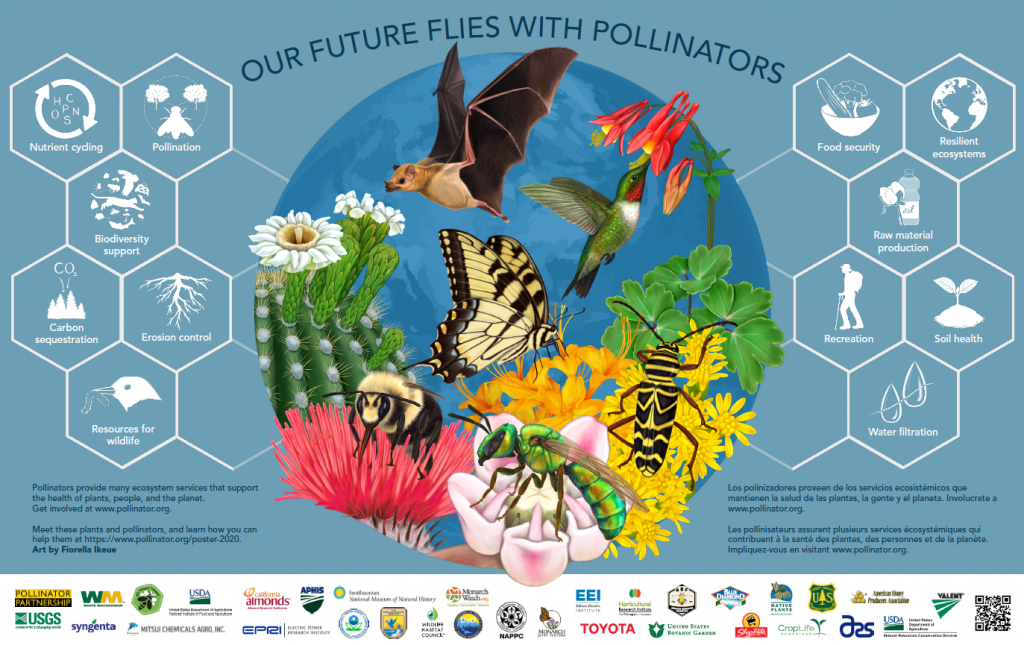Pollinator Paradise at the Arapahoe County Fair
- 2021-07-08
- By mkirk
- Posted in The Garden Buzz
By Lucinda Greene, Horticulture Programs Coordinator and Assistant Horticulturist
During your visit to the Arapahoe County Fair, plan to stop by the Pollinator Habitat Garden in the East Exhibition Hall. Designed and built by Master Gardener volunteers with the help of sponsors Tagawa Gardens and Ewing Irrigation & Landscape Supply, the exhibit showcases common pollinators and their habitat. Learn how to attract these pollinators to your garden by providing food, water, and shelter. The garden features larger-than-life papier-mache models of a two-tailed swallowtail butterfly, a painted lady butterfly and other pollinators including the green metallic sweat bee, a hoverfly, and a broad-tailed hummingbird.
Declining pollinator populations are attributed to loss in feeding and nesting habitats. Pollution, misuse of chemicals, disease, and climate change are also contributing to shrinking and shifting pollinator populations. The Pollinator Habitat Garden helps educate citizens on the importance of pollinator health and the critical role of pollinators in food systems and ecosystems.
Worldwide, 75% of 240,000 plant species depend on pollinators, including many food crops. Hay or forage is the second largest crop in Arapahoe County, ranked by total production acreage. Alfalfa and clover are two important plants in a typical hay mix that require insects for pollination.
Bees, beetles, butterflies, birds, bats, moths, and flies are all pollinators. During pollination, pollen is transferred from the male flower parts (stamens) to the female flower parts (pistils). Fertilization occurs and seeds develop. Bees spend most of their life collecting pollen, which is a protein used to feed their young. Many plants and pollinators have co-evolved to form mutually beneficial relationships. Collecting pollen requires lots of energy, so flowers attract pollinators using bright colors and nectar guides. Plants reward the pollinators with nectar, a mixture of sugar and water. Some pollinator species are specialists, and only pollinate one type of plant.
While the European honeybee, Apis mellifera, is an important pollinator, there are over 900 species of native bees that exist in Colorado. These are solitary bees who dig nests in the soil or in cavities created in trees or other plants. Each pollinator depends on a variety of different plant hosts for food throughout the growing season. The Pollinator Habitat Garden showcases summer-blooming plants such as herbs, perennials, and shrubs. A healthy pollinator garden includes plants that provide nectar sources all season long.
Visit the Pollinator Habitat Garden and talk with Master Gardener volunteers who can provide education on the right plants to add to your landscape. Learn how to plan for season-long bloom and discover simple tips on how to support pollinator habitat at home. Visit our sponsors, Tagawa Gardens and Ewing Irrigation & Landscape Supply, who can provide the materials to help build your very own pollinator paradise.
Horticulture Resources
- Garden Buzz Archives
- CSU Extension Resources
- Colorado Master Gardener Program
- Foothills to Plains Native Plant Master Program
- Native Bee Watch Community Science Program
- The Co-Hort Blog
- PlantTalk Colorado
- Soil Testing
- Plant Select
- Emerald Ash Borer
- Japanese Beetle
- Colorado State Forest Service
- Ask an Expert





